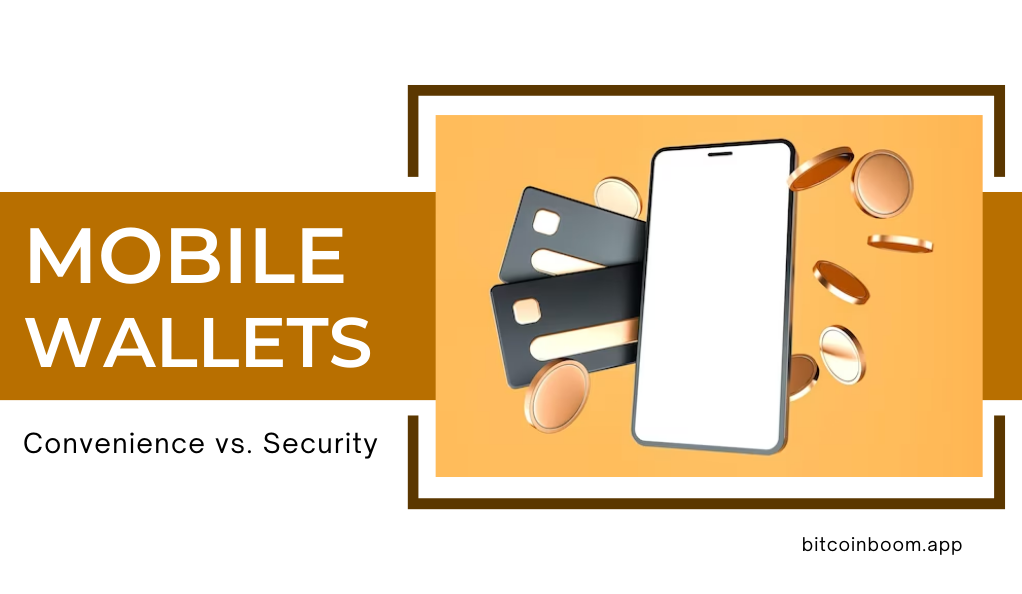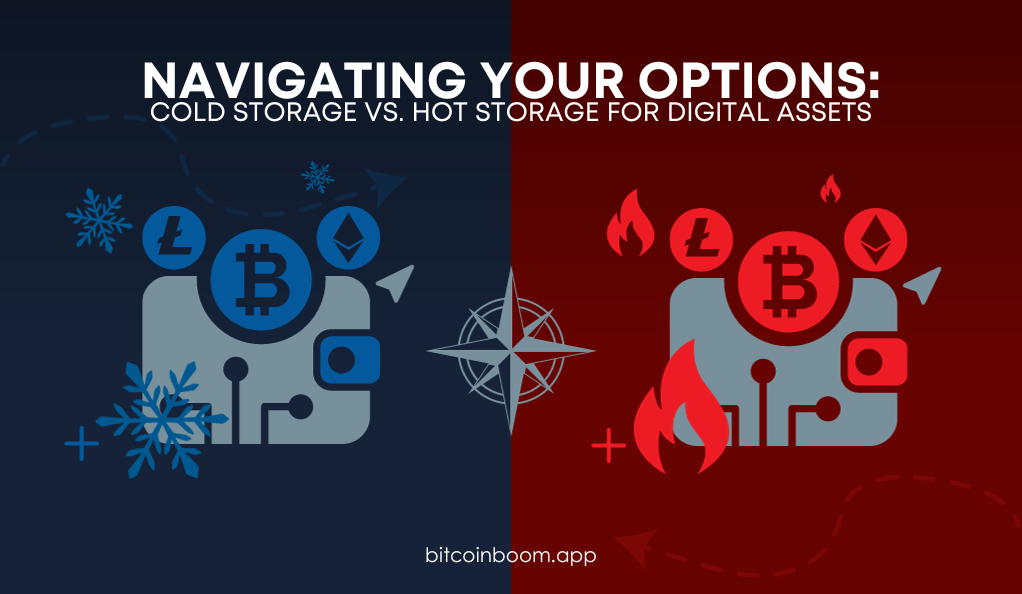In the digital age, the security and management of our virtual assets have become paramount. Whether it’s cryptocurrencies, important documents, or digital media, how we store and protect these assets is a critical consideration. With a myriad of options available, it can be overwhelming to decide which storage method is best suited for your needs. In this comprehensive guide, we delve into the intricacies of Cold Storage and Hot Storage, the two predominant methods of safeguarding digital assets, to help you make an informed decision.
Cold Storage and Hot Storage represent the two ends of the security spectrum for digital assets. Cold Storage refers to keeping a reserve of your assets offline, providing a high level of security from online hacking attempts. On the other hand, Hot Storage is all about accessibility and convenience, with your assets being stored online and readily available for transactions.
The choice between Cold and Hot Storage is not just a matter of security; it also involves considering factors such as accessibility, convenience, and cost. Some users might prioritize the impenetrable security of Cold Storage, accepting the trade-off in terms of accessibility. Others might prefer the ease and speed of transactions that Hot Storage offers, despite its potential vulnerabilities.
What is Cold Storage?
Cold Storage refers to the practice of keeping a reserve of your digital assets completely offline. This method is widely recognized for its superior security features, as it is virtually immune to online hacking attempts. When your assets are stored in Cold Storage, they are inaccessible via the internet, making them safe from the myriad of online threats that exist today.
Types of Cold Storage:
- Hardware Wallets:
- Description: Physical devices that store the user’s private keys securely.
- Pros: Highly secure, immune to online hacking attempts, portable.
- Cons: Can be expensive, risk of physical damage or loss.
- Paper Wallets:
- Description: Physical documents that contain a public address for receiving assets and a private key for spending or transferring assets.
- Pros: Simple, cost-effective, immune to online threats.
- Cons: Risk of physical damage, loss, or theft; not user-friendly for beginners.
- Safety Deposit Boxes:
- Description: Secure storage provided by banks or private security firms to store hardware wallets or paper wallets.
- Pros: Added layer of physical security, protected from environmental damage.
- Cons: Access is limited to the facility’s operating hours, potential cost.
Pros and Cons of Using Cold Storage:
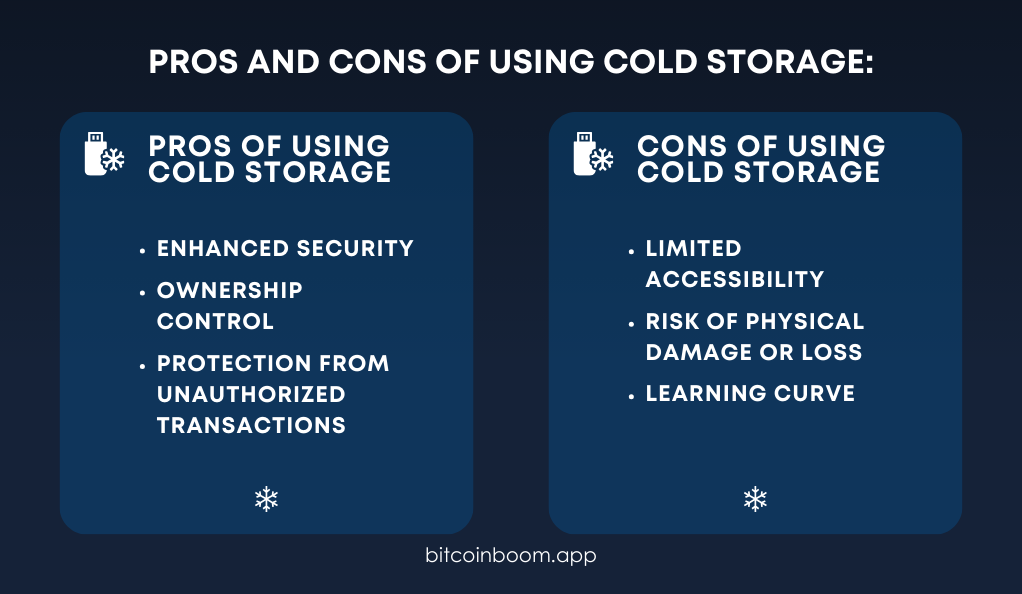
- Pros:
- Enhanced Security: As the assets are stored offline, they are safe from online hacking attempts and unauthorized access.
- Ownership Control: The user has complete control over their assets without reliance on third-party services.
- Protection from Unauthorized Transactions: Since the assets are offline, unauthorized transactions are prevented.
- Cons:
- Limited Accessibility: Accessing assets in Cold Storage can be cumbersome and time-consuming.
- Risk of Physical Damage or Loss: Physical storage solutions are susceptible to damage or loss.
- Learning Curve: For beginners, setting up and managing Cold Storage can be complex.
When to Use Cold Storage:
Cold Storage is ideal for long-term investors or “HODLers” who do not require frequent access to their digital assets. It is also a preferred choice for storing large amounts of assets securely. If your priority is the utmost security and you are willing to sacrifice convenience for peace of mind, Cold Storage is the way to go.
What is Hot Storage?
Hot Storage refers to the storage of digital assets in a manner that keeps them connected to the internet. This method is favored for its convenience and ease of access, allowing for quick and easy transactions. However, this accessibility also makes Hot Storage more susceptible to online threats and hacking attempts.
Types of Hot Storage:
- Online Wallets:
- Description: Wallets that are accessible through the internet, often provided by exchanges or third-party services.
- Pros: Highly accessible, user-friendly, quick transactions.
- Cons: Vulnerable to online attacks, reliance on third-party services.
- Mobile Wallets:
- Description: Wallets in the form of mobile applications, allowing for access and transactions on the go.
- Pros: Convenient, accessible from anywhere, user-friendly.
- Cons: Risk of mobile malware, potential vulnerabilities in app security.
- Desktop Wallets:
- Description: Wallets that are installed on a personal computer.
- Pros: Full control over the wallet, user-friendly interface.
- Cons: Vulnerable if the computer is connected to the internet, risk of malware.
Pros and Cons of Using Hot Storage:
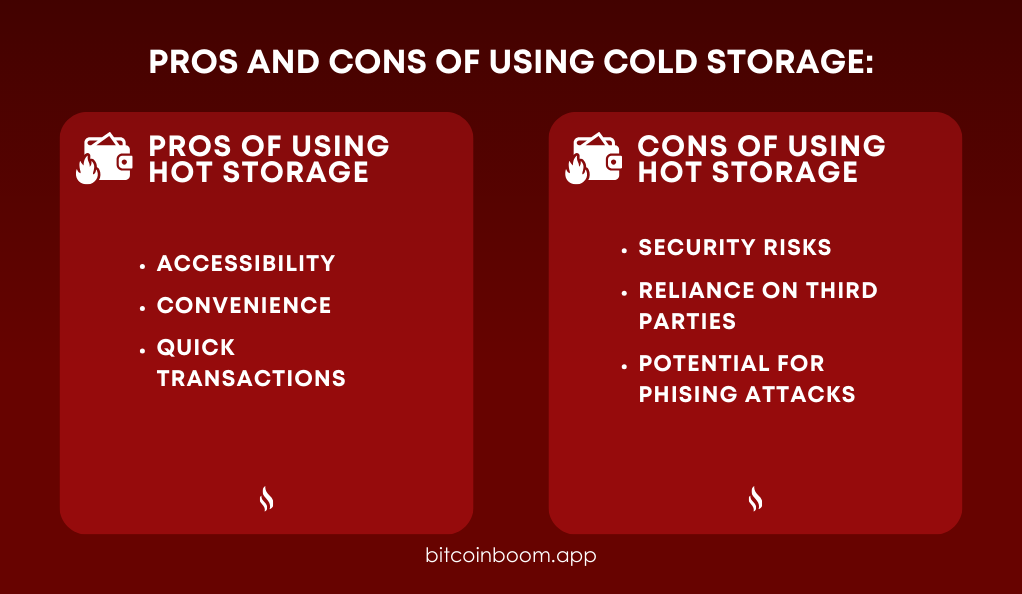
- Pros:
- Accessibility: Assets are readily available for transactions or trading.
- Convenience: User-friendly interfaces make managing assets straightforward.
- Quick Transactions: Ideal for those who actively trade or frequently access their assets.
- Cons:
- Security Risks: Vulnerable to online attacks and unauthorized access.
- Reliance on Third Parties: Often requires trust in the service provider’s security measures.
- Potential for Phishing Attacks: Users must be vigilant to avoid falling victim to scams.
Hot Storage is best suited for individuals who actively trade or frequently access their digital assets. It is also a good option for storing smaller amounts of assets that you might need quick access to. If convenience and accessibility are your top priorities, and you are willing to take necessary precautions to mitigate security risks, Hot Storage offers a practical solution.
Security Aspects: Cold Storage vs. Hot Storage
When it comes to safeguarding digital assets, security is paramount. Both cold storage and hot storage have their unique security features and potential vulnerabilities. Understanding these can help you make an informed decision based on your security needs.
Cold Storage Security:
- Offline Nature: The greatest strength of cold storage lies in its offline nature, making it immune to online hacking attempts and unauthorized access.
- Physical Security: Many cold storage solutions, such as hardware wallets, are designed with advanced security features to protect the stored data.
- Full Ownership: With cold storage, you have complete control over your private keys and, consequently, your assets.
However, it’s crucial to consider the potential risks, such as the possibility of physical damage, loss, or theft. Ensuring the physical security of your cold storage device or document is essential.
Hot Storage Security:
- Encryption and Security Protocols: Hot storage solutions often employ advanced encryption and security protocols to protect your assets.
- Two-Factor Authentication (2FA): Many hot storage services offer 2FA, adding an extra layer of security to your account.
- Regular Updates: Hot storage solutions are regularly updated to address potential security vulnerabilities.
However, the online nature of hot storage makes it susceptible to a variety of online threats, including hacking attempts, phishing attacks, and unauthorized access. It’s vital to be vigilant and take necessary precautions, such as using strong, unique passwords and enabling 2FA.
Comparative Analysis:
| Aspect | Cold Storage | Hot Storage |
|---|---|---|
| Accessibility | Limited; requires physical access | High; accessible from anywhere with internet |
| Convenience | Low; transactions can be cumbersome | High; user-friendly and quick transactions |
| Security | High; immune to online threats | Variable; depends on security measures in place |
| Risk of Theft | Low (online); High (physical if not secured) | High (online); Low (physical) |
| Cost | Variable; one-time cost for physical devices | Often free; potential fees for transactions |
| Control | Full ownership and control | Dependent on third-party services |
The choice between cold storage and hot storage ultimately depends on your specific needs and priorities. If security is your top priority and you’re dealing with a significant amount of assets, cold storage might be the more suitable option. On the other hand, if you prioritize accessibility and convenience for frequent transactions, hot storage offers a practical solution.
Accessibility and Convenience
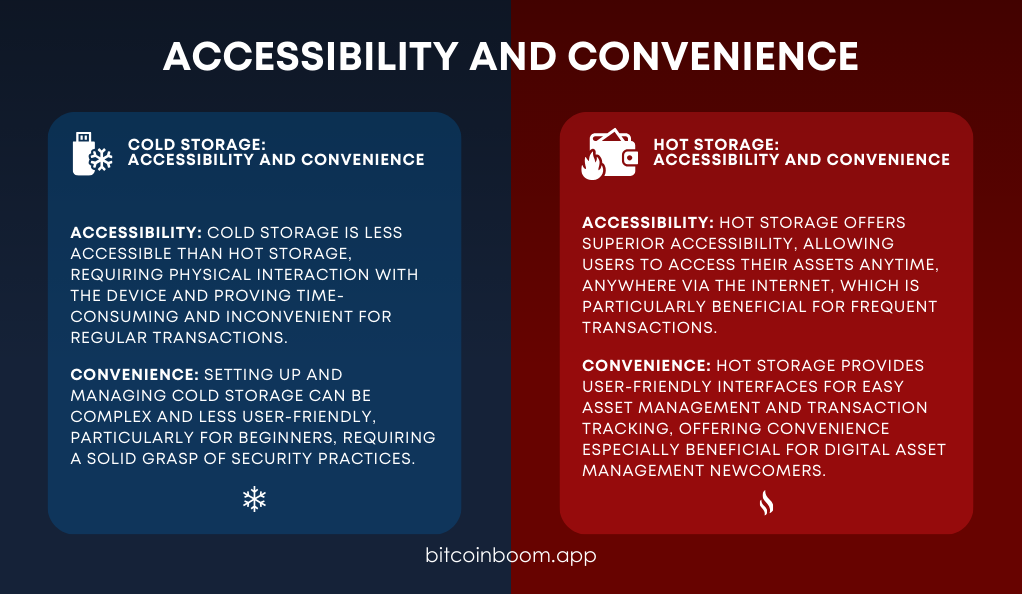
When choosing between cold storage and hot storage, considering how accessible and convenient each option is for your daily use is crucial. These factors play a significant role in determining the overall user experience and efficiency in managing digital assets.
Cold Storage: Accessibility and Convenience
- Accessibility: Cold storage is generally less accessible compared to hot storage. Accessing assets stored in cold storage requires physical interaction with the storage device, which can be time-consuming and less convenient for frequent transactions.
- Convenience: The process of setting up and managing cold storage can be complex, especially for beginners. It requires a good understanding of security practices and might not be as user-friendly as hot storage solutions.
Hot Storage: Accessibility and Convenience
- Accessibility: Hot storage shines in terms of accessibility. Being connected to the internet, assets stored in hot storage can be accessed from anywhere at any time, providing a significant advantage for those who need to make frequent transactions.
- Convenience: Hot storage solutions often come with user-friendly interfaces, making it easier for users to manage their assets, view transaction history, and perform other tasks. This level of convenience is particularly beneficial for those new to managing digital assets.
While cold storage offers enhanced security, it may come at the cost of accessibility and convenience. On the other hand, hot storage provides easy access and a user-friendly experience but with potential security trade-offs.
The key is to strike a balance that aligns with your individual needs and preferences. For instance, you might choose to use cold storage for the bulk of your assets, ensuring their security, while keeping a smaller amount in hot storage for day-to-day transactions and trading.
Cost Implications
When it comes to choosing between cold storage and hot storage, understanding the associated costs is crucial. Each option has its own set of expenses, and being aware of these can help you make a more informed decision that aligns with your budget and investment goals.
Cold Storage: Cost Analysis
- Initial Investment: Cold storage solutions, particularly hardware wallets, require an upfront purchase. This cost can vary significantly depending on the brand and features of the device.
- Maintenance and Replacement: While there are no ongoing fees associated with cold storage, you may incur costs for maintenance or replacement if the device is damaged or lost.
- Security of Investment: The initial cost of a cold storage device is often justified by the enhanced security it provides, especially for significant amounts of assets.
Hot Storage: Cost Analysis
- Transaction Fees: Many hot storage solutions, especially those provided by cryptocurrency exchanges, may charge fees for transactions. These fees can add up over time, especially for active traders.
- Subscription Services: Some hot storage options offer additional features or enhanced security for a subscription fee.
- Free Alternatives: There are also free hot storage wallets available, but it’s important to thoroughly research and ensure they provide adequate security measures.
Tips for Cost-Effective Storage
- Assess Your Needs: Determine how frequently you access your assets and the total value of your holdings to decide which storage option is more cost-effective.
- Diversify Storage: Consider using a combination of both cold and hot storage to balance security and accessibility, potentially saving on costs.
- Research and Compare: Take the time to research and compare different storage solutions and their associated costs to find the best option for your budget.
Future Trends and Developments
The digital asset storage landscape is rapidly evolving, with continuous advancements in technology and security. Staying abreast of these changes is crucial, as they could significantly impact your decision-making process and the safety of your assets.
Cold Storage: Future Prospects
- Technological Advancements: We can expect to see further advancements in the technology behind cold storage solutions, leading to even more secure and user-friendly options.
- Integration with Other Services: Future developments may include better integration of cold storage solutions with various blockchain networks and services, enhancing the user experience.
- Decrease in Costs: As technology advances and becomes more widespread, the cost of cold storage devices may decrease, making them more accessible.
Hot Storage: Future Prospects
- Improved Security Measures: As the prevalence of online threats continues to grow, hot storage providers are likely to invest in enhanced security measures to protect users’ assets.
- Blockchain Innovations: Innovations in blockchain technology could lead to more secure and efficient hot storage solutions.
- Greater Adoption and Integration: As cryptocurrencies and digital assets become more mainstream, we can expect to see a broader adoption of hot storage solutions and their integration into various financial services and applications.
Navigating the Future Landscape
- Stay Informed: Keep yourself updated on the latest developments in digital asset storage to make informed decisions.
- Adaptability: Be prepared to adapt your storage strategy as new and improved solutions emerge.
- Security as a Priority: Regardless of the advancements and changes in the landscape, always prioritize the security of your assets.
Conclusion
Choosing between cold storage and hot storage is a critical decision that requires careful consideration of various factors, including security, accessibility, convenience, and cost. Cold storage offers enhanced security, making it ideal for long-term holding and large sums of assets. On the other hand, hot storage provides ease of access and convenience, suitable for those who frequently trade or access their assets.
By understanding the strengths and weaknesses of each option, as well as staying informed about future trends and developments, you can make a well-informed decision that best suits your needs and preferences. Remember, the safety of your digital assets is paramount, and choosing the right storage solution is a crucial step in ensuring their security.


